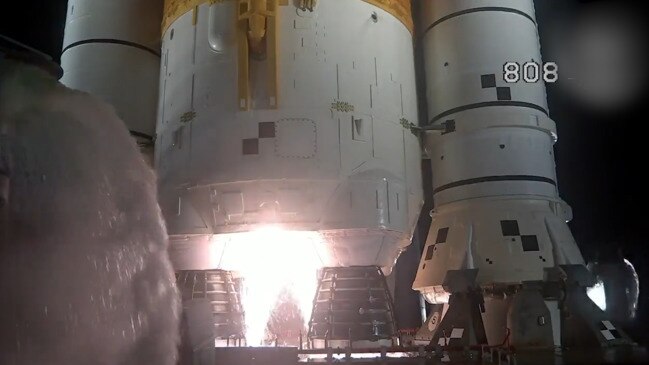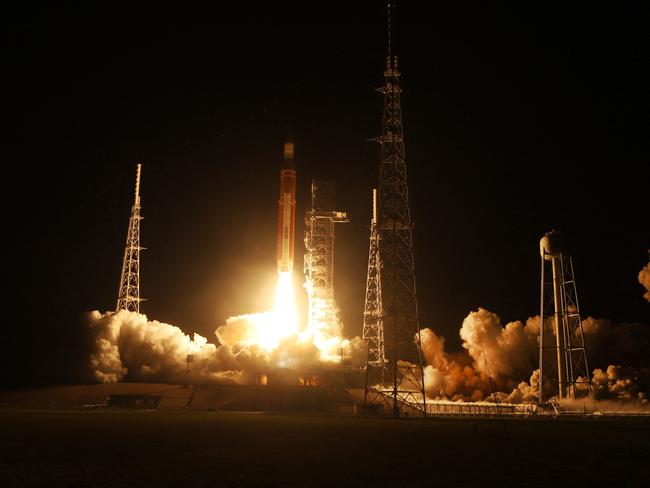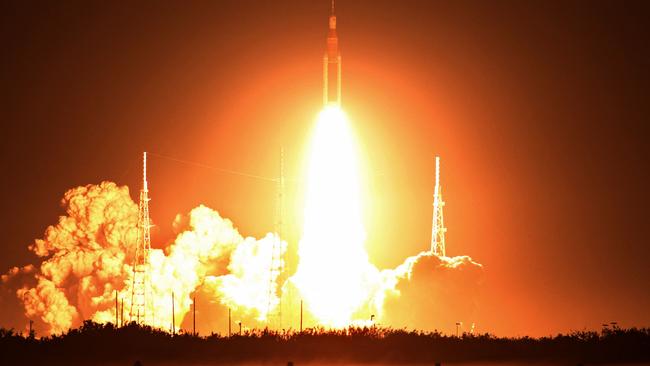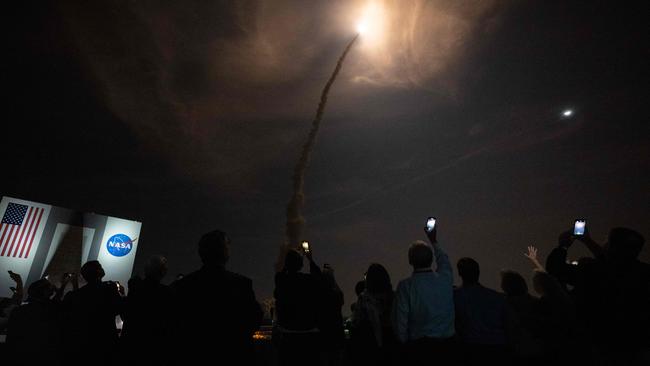Artemis 1: Humans could stay on the Moon this decade, NASA expert says
A NASA official reveals how humans could soon stay on the Moon for lengthy periods after the historic launch of the Artemis rocket.

World
Don't miss out on the headlines from World. Followed categories will be added to My News.
Humans could stay on the Moon for lengthy periods this decade, a Nasa official says.
Howard Hu, who leads the Orion lunar spacecraft program for NASA, told the BBC habitats would be needed to support scientific missions.
It comes after the space agency launched the most powerful rocket ever built on a journey to the moon, in a spectacular blaze of light and sound that marked the start of the new flagship program, Artemis.
Mr Hu said the launch was a “historic day for human space flight”.

He told Laura Kuenssberg that watching Artemis lift off was “an unbelievable feeling” and “a dream”.
“It’s the first step we’re taking to long-term deep space exploration, for not just the United States but for the world,” he said.
“And I think this is an historic day for Nasa, but it’s also an historic day for all the people who love human space flight and deep space exploration.
“I mean, we are going back to the Moon, we’re working towards a sustainable program and this is the vehicle that will carry the people that will land us back on the Moon again.”
Mr Hu told the BBC that if the Artemis flight was successful then the next would be with a crew, followed by a third where astronauts would land on the Moon again for the first time since Apollo 17 50 years ago in December 1972.
The 322-foot-tall Space Launch System (SLS) blasted off from the Kennedy Space Centre in Florida at 01.47am (5.47pm AEDT) last Wednesday, producing a record 39 meganewtons (4.1m kg) of thrust.
“What you have done today will inspire generations to come, thank you!” Charlie Blackwell-Thompson, NASA’s first female launch director, told cheering teammates.
NASA administrator Bill Nelson spoke to reporters after the launch on Wednesday.
“Now we are going back to the Moon, not just for the sake of going to the Moon, but to learn how to live on the Moon in order to prepare to send humans all the way to Mars,” he said.
“This is the next beginning, this is the Artemis generation.”

Fixed to the rocket’s top was the uncrewed Orion spaceship that will orbit Earth’s nearest neighbour, in a test run for later flights that should see the first woman and first person of colour touch down on lunar soil by the mid-2020s.
Orion is designed to carry humans, but its passengers for this test mission are of the inanimate variety, including some mannequins collecting vital data to help future live crews.
One image shared on Wednesday showed Commander Moonikin Campos, one of the Artemis mannequins riding in the capsule, decked out in a survival suit.
About two hours after launch, NASA said the spacecraft had completed a propulsive manoeuvre to escape the pull of Earth’s gravity and was on its path to the Moon.
“Trans-lunar injection burn complete! NASA Orion is on its way to the Moon!” tweeted Jim Free, NASA’s associate administrator for exploration systems.

The Orion spacecraft’s spectacular first views of Earth were shared more than nine hours into the journey, with the vehicle about 91732km away from our planet on its way to the moon.
It’s the first time since the final Apollo mission in 1972 that a spacecraft designed to carry humans has captured a view of Earth.
Orion will come within about 96km of the lunar surface during its close fly-by next week.
After orbiting the moon, Orion will make its return trip, completing its journey in about 25.5 days.
The capsule is then scheduled to splash down in the Pacific Ocean off the coast of San Diego on December 11, when recovery teams will be waiting nearby to haul it to safety.
America last sent astronauts to the Moon during the Apollo era, from 1969-1972.
This time it hopes to build a sustained presence – including a lunar space station – to help prepare for an eventual mission to Mars in the 2030s.
There were nervous moments as teams worked to overcome technical issues that ate into the two-hour launch window, which opened at 1.04am (5.04pm AEDT).
First, engineers were forced to pause the flow of liquid hydrogen into the core stage Tuesday night because of a valve leak, but a team sent to the launch pad resolved the issue after about an hour, by tightening loose bolts.
Later, the space agency reported that a radar site monitoring the rocket’s flight path was experiencing problems due to a faulty ethernet switch, which had to be replaced.
It was third time lucky for NASA after two previous launch attempts were cancelled for technical reasons.
The launch was also delayed due to weather setbacks including Hurricane Ian, which battered Florida in late September.

‘EXTREMELY EXCITED’
About 100,000 people were expected to have gathered along the coast to witness the historic event.
Todd Garland drove from Frankfurt, Kentucky to watch from Cocoa Beach. Wearing an Artemis T-shirt, the 55-year-old told AFP tearfully: “This has been an experience I’ve looked forward to all my life.
“My first memory is my mother waking me up at two years old to watch the Moon landing and I’ve always wanted to see a launch ever since, and now I have.” Kerry Warner, 59, a grandmother and semi-retired educator who lives in Florida, added the launch was “part of America and what America is all about.”

FAR SIDE OF THE MOON
The Orion crew capsule was lifted by two boosters and four powerful engines under the core stage, which detached after just a few minutes.
A final push from the upper stage set the capsule on its way to the Moon, though it will take several days to reach its destination.
The upper stage will meanwhile release 10 CubeSats to carry out science experiments, including one that will unfurl a sail-powered by sunlight and perform asteroid reconnaissance work.
Rather than landing on the Moon, Orion will assume a distant orbit, venturing 64,000km beyond the far side – further than any other habitable spacecraft so far.
Finally, the spaceship will embark on the return leg of its journey. When passing through the atmosphere, the capsule’s heat shield will need to withstand a temperature half as hot as the Sun’s surface.

Though Orion isn’t carrying humans this time, it has three sensor-equipped dummies on board to help gather safety data for future crew members.
The mission will last 25-and-a-half days, with a splashdown in the Pacific Ocean on December 11.
NASA is banking on a successful mission after developing the SLS rocket for more than a decade.
It will have invested more than $90 billion in its new lunar program by the end of 2025, according to a public audit.
Artemis 2 will involve a fly-by of the Moon with astronauts in 2024, while Artemis 3 will see boots on lunar soil, no sooner than 2025.
NASA hopes to settle into a yearly launch schedule, and will include international partners from Japan, Canada and Europe.
– with AFP
Originally published as Artemis 1: Humans could stay on the Moon this decade, NASA expert says




